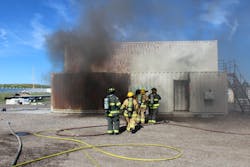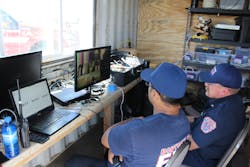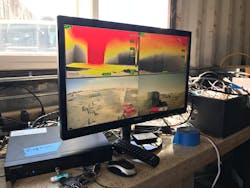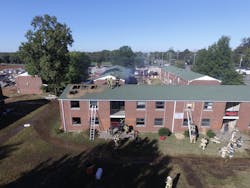From drones to self-driving vehicles, technological advancements are shaping our world in new and exciting ways. The question is, has the fire service changed as the world around us changed? If you pick up any fire service publication or click on any of the countless fire service websites, a common discussion is “Modern Tactics” for today’s modern building construction and fuels. But tactics aren’t the only aspect of our job that is being influenced by modern technology; training has also become very technical with advancements in technology.
When we think of incorporating technology into training, several methods come to mind: Internet-based training, e-learning, video conferencing and digital simulations, to name a few. These can be easy programs to implement; however, there are a few “new-school” technologies that can have a greater impact on your training programs, specifically the use of digital recording systems, thermal-imaging recording systems and drones.
To delve into this topic, I reached out to Manny Muzquiz, the operations chief with Laramie County Fire District (LCFD) #2 in Cheyenne, WY, and Nick Siemens, the director of the Laramie County Community College Fire Science, to discuss how they created and implemented a technologically advanced training program that includes the aforementioned technologies to improve the effectiveness, efficiency and performance of firefighters.
Chief Caughey: How did you recognize the need to utilize technology in training?
Chief Muzquiz: After participating in trainings with Kill the Flashover and visiting with Underwriters Laboratories (UL), where you could watch active fire from monitors and also view temperatures in real time, we at LCFD #2 decided we wanted to attempt to recreate the technology that these two entities were using so that our firefighters could see first-hand the impact of their task-level skills on the fire.
Caughey: What was the impact of seeing real-time temperatures and thermal imaging camera (TIC) video while sitting in a classroom?
Muzquiz: While seated in a remote classroom, it was crazy to be able to see what was going on in a building that had active fire, not only to be able to see the thermal imaging view but also closed-circuit TV cameras. From all the different angles, we were able to see changes in the fire conditions and also the general conditions in multiple areas of the building without having to be in the building physically. I was impressed and felt that having the capability to create these different camera views in our organization, at our trainings, would help to show firefighters what is actually occurring in multiple areas of a building instead of the one-sided view that we are usually subjected to while in fire conditions.
Caughey: Can you describe the digital video and TIC system that you created for your training center?
Muzquiz: We created a three-part digital recording system that records TICs and video cameras that are located in strategic locations in our burn building. Those videos are transmitted to a command center where they can be viewed and recorded. Along with the camera system, we created the ability to record temperature data in our burn building through the use of a thermal couple system. Those temperatures are also transmitted into the command center for viewing and recording.
Caughey: How did you build the system—and was it expensive?
Muzquiz: First off, we are a small combination department in Wyoming. We don’t have the staffing or budget that many of the larger departments have to create such a system. So we had to be frugal and creative to create the system. Fortunately, items that were once expensive to acquire are now relatively inexpensive and readily accessible from retailers like Amazon.com.
The first project we tackled was the basic cameras. For this setup, we used very basic components from retailers like Amazon and Sam’s Club. Our first purchase was a DVR security camera setup. This setup gave us a 16-channel recorder and eight cheap cameras that we could use in fire conditions and not worry about ruining an expensive camera.
The next purchase we made was signal amplifiers/splitters and color quad convertor. The signal amplifiers/splitters allowed us to send a video input to multiple locations. The amplifiers have one input and four outputs. We would wire one output to the DVR and another output to the color quad.
The most expensive part is the TICs. Most companies do not offer a video output that is commercially available on their cameras, but we were able to get a few cameras through Scott ISG that have a video output connection that we were able to plug in and transmit video from the camera into the video equipment. We are hoping that in the future other camera manufactures will include this capability into their cameras.
After all of this was complete, the last step was to connect the DVR to a TV monitor and share the video. The DVR also allows us to record videos for future training sessions.
All of these components, minus the TICs, cost us less than $1,500. Obviously depending on the quality of equipment you choose, this price can vary greatly in either direction; however, this equipment gave us a good start on our video-recording abilities. Note: Many of the TIC manufactures have an internal record system in their cameras. The internal record function works great for viewing the events after training, but we really found that instant feedback was critical in the learning process.
The next step was to recreate the thermocouple setup that UL and KTF were using to capture and record temperatures. We are not scientists, and these thermocouples are scientific devises. With a thermocouple, you are able to record temperatures in multiple areas of a space where heat is present. Initially, this endeavor was frightening to imagine the work and cost that would we would incur to build the system, but after a couple of hours, we had it figured out, and the whole setup was determined to be financially feasible.
We purchased a thermocouple data recorder and thermocouples through a company called OMEGA Engineering. This piece of equipment called a data recorder plugs into your computer, and with some relatively simple software, you are able to measure temperature changes using the actual thermocouple wire that is connected to the data recorder and terminated where you want to record the temperatures. We utilized this technology to broadcast live temperatures to our classroom, allowing students to see the impact of ventilation, hose streams and other fireground tactics. Special thanks to UL Director Steve Kerber for assisting us in developing this part of our system.
Caughey: What was the impact on your firefighters when you began training with this system?
Muzquiz: Wow, where to begin. Firefighters are a tough breed to make believers out of. Think of the old saying, “150 years of tradition, unimpeded by progress”! Our organization is a small, limited-staffed organization that covers over 1,095 square miles—yes, miles! We have three stations with roughly 80 volunteers. And we are dependent on rural water supply for 98 percent of our district.
We determined that in order to provide the best service to our community and to ensure safety of our firefighters, we had to change. In early 2011, we started discussing and training on the simple things like transitional attack or closing the door. Just that simple fireground tactic was nearly impossible to get buy-in from our members because it was so far outside what most of us learned or were taught about the fireground. That all changed when we witnessed the first live video streaming of modern tactics and the immediate temperature drop and improved conditions for search and fire control. Our members were in awe of what they were seeing, and they immediately wanted to know more about why and how those modern tactics impacted the fire so quickly. This opened the door for us to introduce more research and data to them.
The other major impact that we didn’t expect from the video training was the impact on each firefighter having the opportunity to review their own personal performance. Through the use of the video recording system, we were able to provide better instruction on nozzle control techniques, door control and other techniques that had been difficult to teach. In many cases, the firefighters overcame poor technique through brawn and determination. With the video system, we were able to review and coach better, more efficient techniques with them. This led to less fatigue and more efficient and effective task-level work for our members, which in our organization, where we arrive on scene with one engine for the first 7–10 minutes, is critical in what we can accomplish on the fireground.
The use of unmanned aerial vehicles (UAVs, aka drones) in addition to our video-recording system added to our ability to document and train our members on exterior operations, and in our world, the importance of wildland events. With the success of our video recording of structure fire events, we thought we could have the same impact on other areas of our training.
To do this, we reached out to Nick Siemens, director of the Fire Science program at our local college, Laramie County Community College. Siemens had been utilizing drones in different aspects of his college program. His influence has aided us in the development and utilization of drone video in other areas of our training program.
Chief Caughey: How did you get started utilizing UAVs?
Director Siemens: We began using UAVs as a marketing tool for our Fire Science program. By creating drone videos, we were creating a new energy, which was attracting more students. Unless you are living under a rock, you have noticed the explosion UAVs. Over the last few years, UAVs have become affordable, and the use of UAVs can provide an entirely new training perspective. Many training scenarios involve simultaneous activities taking place with multiple resources that cannot be viewed from the command post. Having an “eye in the sky” allows the training officer to see the big picture as needed and, when necessary, can be immediately relocated to observe and record a specific task.
Caughey: What challenges did you face in selecting a UAV?
Siemens: Because UAVs are relatively new and the industry is growing so rapidly, the government is having a difficult time regulating how, when and where these tools can be used. Four separate groupings have been recommended to the FAA for categorizing UAVs based on their size and capabilities. The first category includes UAVs less than 250 grams (8.8 oz), while the fourth group involves UAVs designed for extended flight times over crowds of people and requires a safety plan for exiting the area in the event of a flight malfunction. The UAVs included in those categories are not likely to be used in fire department training applications. The middle two levels include the consumer-level UAVs, such as the DJI Phantom models, which can be purchased for around $800 and up depending on the accessory package that is chosen. Industrial and commercial UAVs make up the third category and include models like Yuneec's Typhoon, which can be purchased for around $1,200. Both DJI and Yuneec offer models that can be equipped with TICs, however this addition can more than triple your initial cost investment. (One website lists the DJI TIC package starting at $14,200.)
Not all departments will need an aerial TIC, though, and UAVs can be equipped with a variety of tools, such as zoom lenses or light payload delivery, depending on the organization’s specific desires. The most obvious use for any of these remote-controlled cameras is simply the ability they provide the organization to document the activities that occur on the training ground. Any UAV that will be operated by, or around, firefighters needs to be durable and be able to stand up to potential aggressive usage. Some UAVs are now waterproof or weather-hardened, which is another option to consider when researching your newest training tool.
Caughey: What advice would you have for new training officers utilizing UAVs?
Siemens: One early coaching responsibility of the training division will be to educate participants about the UAV. After the initial novelty wears off, it will be important for those on the training site to be aware of the UAV’s presence. Crews will need to avoid spraying the UAV with the hose stream, and any other horseplay that could damage the expensive piece of equipment must be eliminated. Firefighters and other training attendees must remain aware of the risk when working around these expensive tools.
Proper training for those who will be piloting the UAV is a must. Some consumer-level UAVs come with a flight simulator that can be used with a smartphone or tablet and allows pilots to practice flying without the device ever leaving the fireground/training ground. For credibility, those in charge of operating the UAV should have their FAA Part 107 license, and the department should create a strong standard operating procedure (SOP) for how and when the UAV will be used. The organization or municipality should also consider obtaining a Certificate of Authorization that allows for UAV usage in broader areas. There are numerous companies that offer both hands-on and Internet-based training to help pilots prepare for the Part 107 license, including sites like remotepilot101.com or unmannedexperts.com. This type of training and certification can add credibility to the pilot, the training division and the entire organization.
Once your organization has implemented the UAV and recorded some training footage, then the follow-up instruction can begin. Mid-level and higher UAVs use simple programs that allow the user to download the media to a phone, computer or tablet, where it can be evaluated, emailed or replayed to emphasize the training subject. Training activities are also great material for recruitment/retention videos, so make sure to forward the footage to your organization's public relations department as well.
In sum
The use of video has been prominent in professional sports for decades. If you want to be a PGA golfer, you will spend hundreds of hours reviewing video of your swing, analyzing how to be more efficient and consistent. If you have ever played football, you have spent countless hours studying the videos of your competitors. Utilizing technology in your training program greatly impacts the efficiency and effectiveness of your firefighters.
Don’t fear technology, embrace it and utilize its potential to enhance the safety and performance of your organization.
About the Author
Jason Caughey
Jason Caughey is the fire chief of Laramie County Fire District #2 in Cheyenne, WY, and an adjunct professor for Laramie County Community College, where he teaches on the principles of fire behavior. Prior to arriving in Cheyenne in 2011, he was the fire chief of Gore Hill Fire Rescue in Great Falls, MT. He also spent 10 years working for the Montana Fire Services Training School as a regional instructor and regional training manager for the state of Montana. Caughey has been an active member in the "Kill the Flashover" project, led by Joe Starnes. He is also a current technical member of the UL Positive Pressure test committee and a lead instructor for the Ottawa Project “Knowledge to Practice.” Caughey has a bachelor’s degree in fire science from Columbia University.




